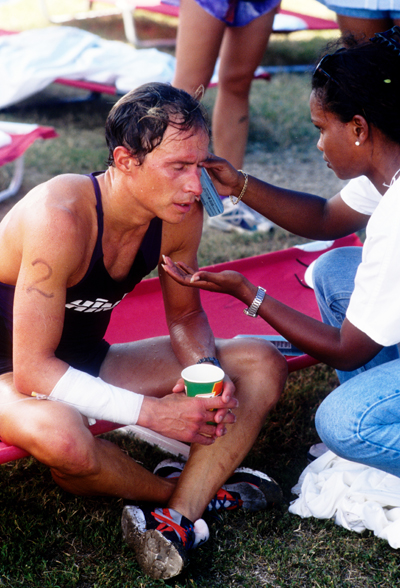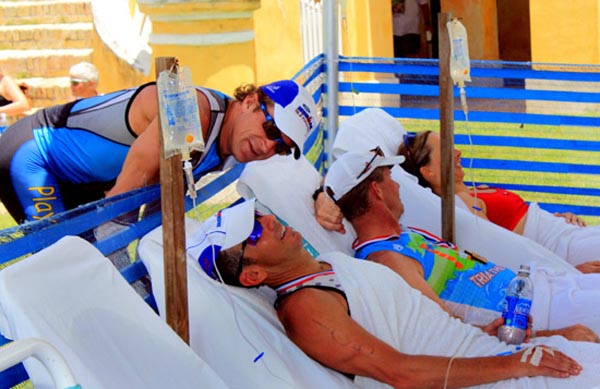By Jimmy Riccitello

I’ve lived and trained in Tucson since 1977. To state the obvious – summer in Tucson is HOT.
With regard to training in the heat (or any subject, for that matter) I’m not scientifically educated – not in a school sense, anyway. But it’s funny how trial and error (anecdotal evidence) and following your instincts based on the results of trial and error, can lead one to validate factual scientific data.
When I started triathlon in 1984, I was told that “they” said to do well in the heat, you must train in the heat. So I used to delay the start of my workouts so that I would be doing the crux of my training at the hottest time of day. The only positive thing I accomplished with this heat training strategy was a nice tan. Everything else suffered. My training gains suffered, my race results suffered, I was sick more often, unmotivated, and generally hotter than a snake’s ass in a wagon rut – constantly – even when I was inside the house sitting on the couch watching a taped rerun of The Iditarod with a cool beverage.

Common sense and the desire to stop sweating profusely while lying in bed at 11pm with the ceiling fan set on “hyper drive” due to massive amounts of stored body heat accumulated from a 5 hours ride at midday in June, caused me to rethink my strategy about the total amount of training I completed during the heat of the day.
I started my bike practice at 5am, which got me home at between 8 and 10am, depending on the duration of my ride. I still had to ride when it was hot out, but not when it was super hot – and only for an hour or two (vs. the entire ride when I was starting at 9am).
I immediately noticed an improvement in the quality of my bike practice when leaving earlier. And strangely (duh), subsequent workouts improved dramatically as well.
I also noticed that my performances in hot weather races did not suffer due to less training in the heat. It didn’t seem obvious back then, but it turns out that ANY training outside in Tucson during the summer qualifies as heat training. Who knew?
Once I figured out that 3-5 hours in the “cool” early Tucson summer mornings adequately prepared me for any race held in any climate cooler than the Sahara Desert – I needed only to figure out how to keep up with the massive amounts of sweat I lost during the Tucson summer.
It’s common knowledge (propagated by “they”) that we all sweat more than normal when it’s hot out and each of us has a unique sweat rate (some of us sweat more or less than others). I happen to be a profuse sweater who sweats profusely. The amount of sweat I excrete under normal temperatures borders on freakish. My world-class sweating skills were first noticed after one of the famous Tuesday runs in Rancho Santa Fe (North San Diego County) in the summer of 1986.
It was my first run with the SD crew and I was hoping to leave a good impression – which I figured would be tall order considering I was perhaps the slowest running professional triathlete in the sport, at the time. As fate would have it, on the particularly balmy day in North County, Scott Tinley, one of the patriarchs of the Rancho Santa Fe run, decided to challenge perhaps the most legendary of triathlete sweaters, Scott Molina, to a “sweat-off.”

A sweat-off is a way of determining who sweats the most. Why this was important remains to be seen – but I can only imagine that I, and others, were unknowingly participating in one of the early experiments on sweat. To determine the winner (person who sweat the most) – runners wring out their sweaty t-shirt, post run, into a Big Gulp cup. The runner who fills the cup the highest with their sweat, is declared the winner. I know – we were ahead of our time.
Molina, typically nonplussed with the challenge, instructed Tinley to “Pick your three best sweaters.” I noticed Tinley hopefully looking my (the new guy) way. “Can you sweat,” he asked? “I can sweat,” I responded.
After 12 hard, hilly, sweaty miles, we took Molina down. It was big news on the scene, since three people had never before collectively out-sweat Molina. From that day forward, I was known as a well above average sweater – pound for pound, among the best. Another thing that became obvious to me after participating in this contest/experiment was that there is no correlation between the amount a person sweats and whether they are a fast runner or a slow runner (you can sweat a lot a do well, and you can sweat a lot and suck).
This aside, I always had trouble drinking enough during racing and training. Because of my high sweat rate, I was always told that “they” said to drink frequently and in large quantities during training bouts and races. Despite this advice, I quickly discovered that it’s very difficult – a downright pain in the butt – to drink frequently and in large amounts when you’re groveling for all you’re worth, simply to stay on the wheel of the person in front of you.
It’s also hard to drink when you’re running – whether racing or training. It was extremely rare if anyone could be bothered to grab a drink – even when there were aid stations.
Swimming was never much of an issue for me, since there was always a pool’s worth of water available to drink. I still fail to understand why athletes feel the need to put a water bottle at the end of their lane. It seems unnecessary to me.
Anyway, I found it very difficult to stay on top of being optimally hydrated while dealing with three workouts per day during the summer months, by following hydration strategies that “they” outlined. Eager for answers – I asked Molina how he coped. He told me that he simply chugged a liter or two of fluids right before a workout. Then he drank when he could during the exercise bout. I figured if this strategy worked for the most legendary sweater in triathlon (and probably the winningest triathlete of all time), it was good enough for me. Despite the fact that Molina’s hydration strategy was quite different to anything “they” recommended (keep in mind we’re talking about the late 1980s) – it worked very well for me, once I got used to the bloated feeling early in my workouts.
My point is that what “they” say we should do, and what the best actually do – is often very different. If we can open our minds to alternative methods and honestly evaluate the results of our trial and error – we may learn a few tricks that put us ahead of the curve.
With this in mind, here are links to a couple articles that I wish were readily available to me back in the old days – days when hydration strategies were developed based on the amount of sweat that was wrung from a t-shirt into a Big Gulp cup.
